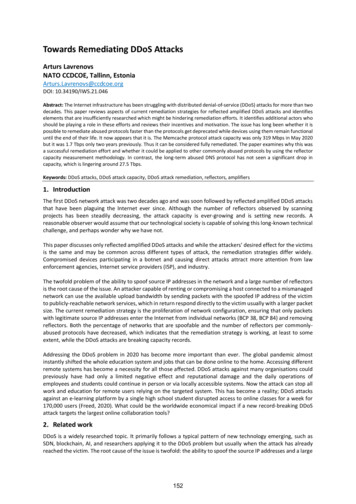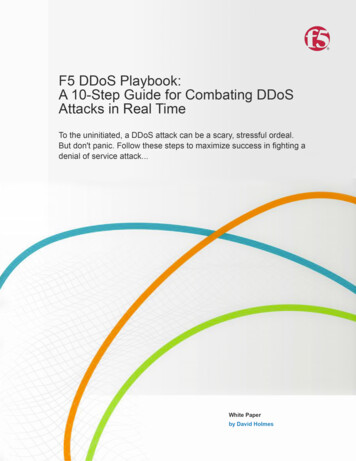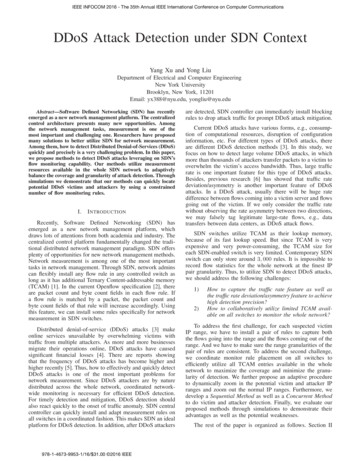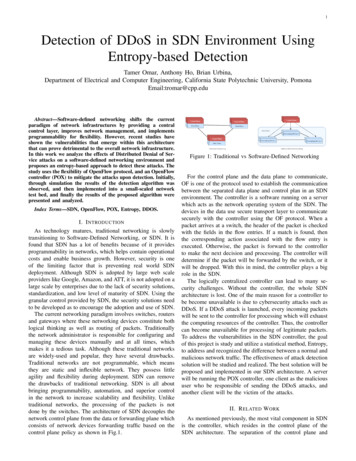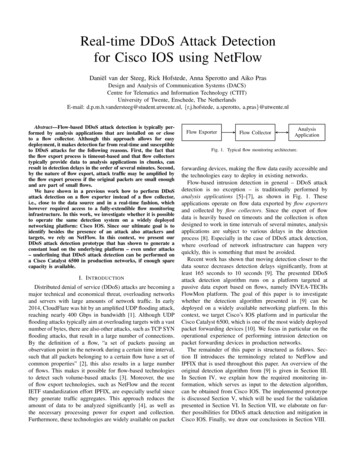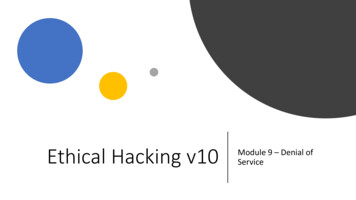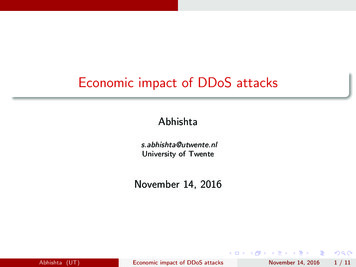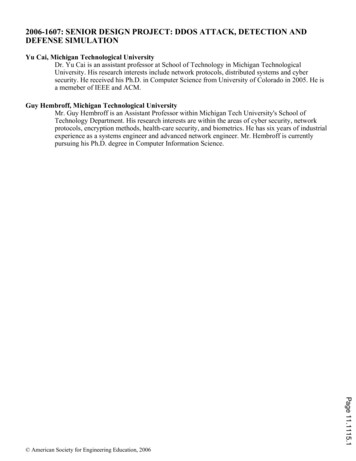
Transcription
2006-1607: SENIOR DESIGN PROJECT: DDOS ATTACK, DETECTION ANDDEFENSE SIMULATIONYu Cai, Michigan Technological UniversityDr. Yu Cai is an assistant professor at School of Technology in Michigan TechnologicalUniversity. His research interests include network protocols, distributed systems and cybersecurity. He received his Ph.D. in Computer Science from University of Colorado in 2005. He isa memeber of IEEE and ACM.Guy Hembroff, Michigan Technological UniversityMr. Guy Hembroff is an Assistant Professor within Michigan Tech University's School ofTechnology Department. His research interests are within the areas of cyber security, networkprotocols, encryption methods, health-care security, and biometrics. He has six years of industrialexperience as a systems engineer and advanced network engineer. Mr. Hembroff is currentlypursuing his Ph.D. degree in Computer Information Science.Page 11.1115.1 American Society for Engineering Education, 2006
Senior Design Project:DDoS Attack, Detection and Defense SimulationAbstractDistributed denial-of-service (DDoS) attack is a rapidly growing threat to today’s Internet.Significant research works have been done in this area. It is vital to incorporate the latestresearch works in academic program to provide training and education to students andprofessionals for cyber security.In this paper, we present the design and implementation of a senior design project namedDDoS Attack, Detection and Defense Simulation. We aim to build a test bed and configurethe network environment to simulate the “real-world” DDoS attack, detection and defense.We study several DDoS attack tools, as well as some commonly-used DDoS detection anddefense software. We perform extensive tests, collect and analyze the experimental data, anddraw our conclusions. This is an on-going project. Some preliminary results have beenreported here.The purpose of this project is to help students to apply their technical skills and knowledge ona “real world” project, and gain better understanding and more hands-on experience onInternet security, especially DDoS attack, detection and defense mechanisms.1. IntroductionNetwork security is a topic gaining tremendous interests in today’s Information Technologyworld. The increasing frequency and severity of network attacks in recent years reveal somefundamental security issues of Internet environment. Significant efforts from university andindustry have been made to improve computer and network security. It is vital to incorporatethe latest research results in higher education and academic programs to provide training andeducation to college students and cyber security professionals.College seniors in Computer Network & System Administration (CNSA) program [1] atMichigan Technological University are required to complete a capstone senior design projectduring their final year. The senior design project affords students the opportunity to applytheir individual technical skills and knowledge on a real world project, as well as developtheir problem solving skills, communication skills, and teamwork skills.DDoS attack has become a rapidly growing threat to today’s Internet. A large number ofDDoS detection and defense mechanisms have been proposed to combat the problem.In this paper, we present the design and implementation of an Information Technology seniordesign project named DDoS Attack, Detection and Defense Simulation. In this project, weaim to set up test bed and configure the network environment to simulate the “real-world”DDoS attack, detection and defense mechanism. We test several DDoS attack software, aswell as some leading DDoS detection and defense products and tools.Page 11.1115.2The purpose of this project is to help student gain better understanding and more hands-onexperience on Internet security, especially DDoS attack, detection and defense mechanisms.
2. BackgroundA DDoS attack is one in which a multitude of compromised computer systems attack aselected target, thereby causing denial of service for legitimate users of the targeted system.The flood of incoming traffic to the target system essentially forces it to shut down, therebydenying service to users.Figure 1 shows a typical DDoS attack [2]. A hacker begins a DDoS attack by exploitingvulnerability in a computer system and making it the DDoS "master". From the mastersystem, the intruder identifies and communicates with other systems that can becompromised also. The intruder loads DDoS attack tools on those compromised systems. Theintruder can instruct the controlled machines to launch one of many flood attacks against aspecified target. The inundation of packets to the target causes a denial of service. SomeDDoS attacks utilize Internet worms to automate the process of exploiting and compromisingcomputer systems, as well as launching DDoS attacks.In general, DDoS defense research can be roughly categorized into four areas: intrusionprevention, intrusion detection, intrusion response, and intrusion tolerance. Intrusionprevention focuses on stopping attacks before attack packets reach the target victim. Intrusiondetection explores the various techniques used to detect attack incidents as they occur.Intrusion response investigates various techniques to handle an attack once the attack isdiscovered. Intrusion tolerance responds to attacks by minimizing the attack andwidthClient(Attack Attacker)Figure1 – A typical DDoS attackPage 11.1115.3MastermindIntruder
3. Project Design and ImplementationThis project is divided into three phases.The first phase of this project is to build a DDoS attack network and simulate the DDoSattacks. We test some existing DDoS attack tools, like StacheldrahtV4 [3]. We also developseveral simple DDoS attack programs by ourselves. For example, programs that can launchping flood attack or UDP attack. On the victim network, we use Apache web server [6] andRealPlayer Multimedia Server [7]. The students can observe how DDoS attacks affect thenormal users and normal traffic.The second phase of this project is to set up DDoS Intrusion Detection and Defense systems.We use Snort [8], as well as several other leading products in market. We perform extensivetests and compare these DDoS defense products. We design our own defense mechanism byintegrating Snort with Firewall and router to enable effective rate-limiting and QoSprovisioning. This requires students to have good understanding on TCP/IP, iptable [9],firewall and router.The last part of this project is to further the studies on DDoS attacks. For example, there is anew type of DDoS attack called degrading DDoS attacks, or non-disruptive DDoS attacks.This type of DDoS attack consumes a large portion of victim network resources but does notstop the network services completely. The traditional DDoS defense mechanisms react poorlyto degrading DDoS attacks. We also try to combine Internet worms with DDoS attacks. Forexample, Code Red worm [4] and SQL Slammer worm [5].Phase III is probably too challenging and may go beyond the capability of college seniorsfrom a technological university. We decide to make phase III optional, but stronglyencourage students to further their studies. Student will get extra credit if they can makeprogress in this research area.Page 11.1115.4Figure 2 – DDoS Attack, Detection and Defense Test-bed
Figure 2 shows the test bed built for the DDoS attack, detection and defense simulation. Themachine configuration is as follows: PIII 667MHz, 256MB RAM, and100Mb Ethernetconnection. We build several virtual machines to expand the test bed. The operating systemsare Linux Fedora Core 4 [11] and Windows server 2003. StacheldrahtV4 is used as the DDoSattack tool.4. Preliminary ResultThis is an on-going project. We report some preliminary results as follows. The data iscollected by using TCPdump [12]. The figures are drawn using GNUplot [13]. Figure 3shows the normal traffic condition without DDoS attacks. X axis is the time in second; Y axisis the amount of traffic in packet/second. It is observed that the amount of traffic is around 40packets per second, except for the initialization stage. It is normal to have larger datatransmission rate at the initialization stage.Figure 3: Traffic condition before DDoS attackFigure 4: Traffic condition after DDoS attackPage 11.1115.5
Figure 4 shows the traffic condition after DDoS attacks. The attacks are launched at 150second. It is observed that the normal traffic is interrupted. The traffic is either being almoststopped, or becoming bursty and unpredictable.Figure 5 show the traffic condition after DDoS detection and defense. The IntrusionDetection System (IDS) on end server raises intrusion alert and notify the firewall system.The firewall takes appropriate actions based on the intrusion alert and traffic condition. Forexample, firewall can drop packets from certain IP addresses, or rate-limit traffic from certainsources. It is observed that the traffic is brought back to normal after the intrusion detectionand defense.Figure 5: traffic condition after DDoS defense5. Project Management and AssessmentThis is a project for two senior students. They work as a team. Each team member must playa active role in designing, building, testing and troubleshooting the project. Every weekstudents are required to submit a progress report and meet with the project advisor (faculty)for one hour. There is a monthly presentation meeting where different senior project teamswill meet together and give a 15 minutes presentation to the advisor and their peers. Studentsare required to use Microsoft Project [10] to manage the progress of the project. At the end ofthe spring semester, students need to submit their final project report and take the oral projectdefense.Page 11.1115.6The department uses the senior project as an assessment tool to evaluate students’ academicachievements. Students’ final grades are based upon the following factors.‚ Quality of the project‚ Quality of the report‚ Project defense‚ Documentation‚ Monthly presentation and weekly report‚ Peer evaluation
6. ConclusionIn this paper, we present the design and implementation of a senior design project namedDDoS Attack, Detection and Defense Simulation. We build test bed, install the software,configure the network environment, and perform extensive tests. Some preliminary resultsare reported. The purpose of this project is to help student gain better understanding and morehands-on experience on Internet .CNSA at MTU. http://www.tech.mtu.edu/cnsa/Angela Cearns, Design of an Autonomous anti-DDoS Network. Master thesis, University of Colorado atColorado Springs, 2002.StacheldrahtV4, http://cs.uccs.edu/ scold/ddosCode Red Worm, .worm.htmlSQL Slammer Worm, /data/w32.sqlexp.worm.htmlApache, http://www.apache.orgRealplayer, http://www.realplayer.comSnort, http://www.snort.orgIptable, torial.htmlMicrosoft Project, efault.mspxFedora Core 4, http://fedora.redhat.com/TCPdump, tmlGNUplot, http://www.gnuplot.info/Page 11.1115.7
DDoS Attack, Detection a nd Defense Simulation Abstract Distributed denial-of-service (DDoS) attack is a rapidly growing threat to today s Internet. Significant research works have been done in this area. It is vital to incorporate the latest research works in academic program to provi de training and education to students and
